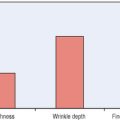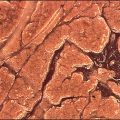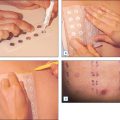Chapter 24 Dyspigmented Skin
Unwanted pigmentation of the skin is a difficult dermatologic condition to treat. Epidermal pigment is accessible to a variety of cosmeceutical actives, but dermal pigmentation does not reliably respond to any topical therapies. The cosmeceuticals available for decreasing pigmentation include vitamins, botanical extracts, penetration enhancers, and hydroquinone. None of these substances can reliably produce decreased pigmentation in persons of all skin types. Usually, a variety of complementary actives to lighten skin produce the best results.
Table 24.1 lists the cosmeceuticals that are currently in the literature for pigment lightening. This table is useful when planning patient therapy, since it lists the mechanism of action and any pertinent patient selection comments. Hydroquinone has always been the mainstay of pigment lightening treatment; however, it is an unstable radical that can produce irritation and has a cytotoxic effect on melanocytes. For this reason, hydroquinone is not allowed in skin lightening products sold in Japan. There is concern that hydroquinone may also be removed from the market at some point in the United States. This has spurred research into a variety of vitamin and botanical pigment lightening agents. Of these, kojic acid, glabridin, and azelaic acid show the most promise by all functioning as tyrosinase inhibitors. Best results are achieved when these agents are used in combination with penetration enhancers, such as glycolic acid, and pigment lightening vitamins, such as niacinamide and retinol. Care must be taken not to induce irritation that may result in postinflammatory hyperpigmentation, especially in persons of darker skin color.
Table 24.1 Cosmeceuticals for dyspigmentation
| Cosmeceutical | Effects on skin physiology | Patient selection comments |
| Niacinamide | Inhibition of melanosome transfer from melanocytes to keratinocytes | No irritation, weak skin lightening agent |
| Retinol | Inhibits tyrosinase, interferes with pigment transfer | Mild irritation, weak skin lightening agent |
| Ascorbic acid (vitamin C) | Interacts with copper ions at tyrosinase active site | Magnesium-L-ascorbic acid-2-phosphate is more stable form, weak skin lightening agent |
| Kojic acid | Tyrosinase inhibitor from fungus | Mildly irritating and a possible allergen |
| Glabridin | Tyrosinase inhibitor from licorice | No cytotoxicity, no irritation, most common skin lightener in US cosmetics |
| Arbutin | Glycoside that inhibits tyrosinase from bearberry fruit | Less potent than kojic acid, must be used in combination with other skin lightening agents |
| Paper mulberry | Tyrosinase inhibitor from mulberry tree roots | Low irritation, same potency as kojic acid, not commercialized in US |
| Soy | Fresh milk inhibits PAR-2 pathway and melanosome transfer | Only present in fresh soy milk, difficult to stabilize |
| Azelaic acid | Dicarboxylic acid derived from Pityrosporum ovale that is tyrosinase inhibitor | Slight stinging upon application, effective skin lightening agent |
| Aloesin | Aloe vera derivative that is competitive inhibitor of DOPA oxidation, noncompetitive inhibitor of tyrosine | Weak skin lightening agent |
| Glycolic acid | Sugar-derived alpha hydroxy acid that increases exfoliation of pigmented skin, penetration enhancer of other skin lightening actives | Irritating at high concentrations, may induce postinflammatory hyperpigmentation |
| Hydroquinone | Tyrosinase inhibitor, cytotoxic | Highly reactive radical, very irritating, effective skin lightening agent |





